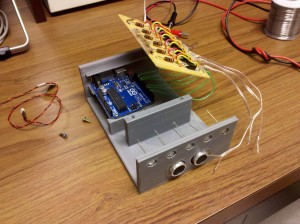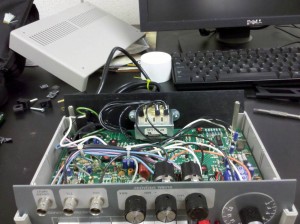Hello everyone,
On a quiet Friday afternoon, it’s not so quiet in the 3D Lab. As the community discovers what Wayne College has to offer, folks trickle in continuously, having heard about the lab from fellow students, the website, our offsite demonstrations, and general word-of-mouth. For instance, the below photos are what’s happening in the lab right now:
Heat pressing vinyl onto t-shirts
Wiring an automatic brake light system
Modifying a box for R/C airplane parts
CAD designing and 3D printing
Speaking of projects, one of our Akron campus students uses our new Electronics Station to work on his latest invention, a velocity-dependent slow moving vehicle bicycle taillight system for his senior design project through the UA Human Powered Vehicle Team.
The system will automatically light-up the brake lights as “parking lights” while the bicycle is in-motion, change their intensity based on bike speed, and flash them when cars are approaching from behind. Powered by a low-cost Arduino Uno microcontroller, accelerometers, proximity sensors, LEDs, and other hardware, Don also designed and 3D printed a custom enclosure for it. We are excited to see this unit in-action!
Though not technically at the Wayne College 3D Lab, do you know there is a makerspace in Creston, Ohio? Barry Romich hosts an open-to-the-public space where folks can use laser cutters, CNC machines, welding/machining/woodworking, and other fabrication tools. You never know who is hanging out there and what projects are being worked on; it’s an area of constant invention and creativity.
Currently at this makerspace, Fred and his high school son are building a marimba, a percussion instrument consisting of a set of wooden bars struck with mallets to produce musical tones. They are using a CNC milling machine called a ShopBot to carve their own wooden bars. This is accomplished by milling slots in the edge of a 3/4″ x 3-1/2″ x 6′ oak board. The slots are 5/8″ deep, 0.260″ x 0.150″ and are just over 2″ in spacing. Once the bars are carved, the two inventors will drive aluminum brackets into the slots to support the marimba keys. Normally, the ShopBot does not support boards this large, but Barry, Fred, and son were able to modify the machine to take the 6’ oak boards. It’s an amazing project!
We are happy to announce the completion of our Electronics Station in the 3D Lab. Many thanks to Mike who not only helped assemble the components, but deep cleaned the switches & buttons, repaired & cleaned circuit boards, and much more. The station allows students to solder, build circuits, create Arduino and Raspberry Pi projects, and provides an oscilloscope, component tester, power supply, function generator, counter, bread boards, and more. Students are already using the station for soldering, circuit building, and building their own Arduino projects such as the brake light system above. We are proud to offer this service to our students and to the community.
The finished station
Throughly cleaning our electronics equipment
The laser engraver in the 3D Lab supports a wide range of materials for cutting and engraving, from plastic, wood, glass, mable, leather, etc. Not so well known is that certain plastics, when burned or engraved, can emit toxic gas. PVC is a prime example of this.
Occassionally, students will bring unknown plastics to the lab. Policy dictates that unknown plastics are not to be used on the laser engraver. But we discovered a wonderful online resource (courtesy of Boedeker.com) to determine a plastic’s composition using “the burn test.” Using a match stick or cigarette lighter in a hooded/vented enclosure, plastic can be roughly identified by its burn color, odor, drip rate, and burn rate. Once the plastic is identified, it is easier to determine the plastic’s compatibility with laser engraving. Click below for details:
http://www.boedeker.com/burntest.htm
A Brazilian macaw named Gigi has become the first to receive a 3D-printed beak (thanks for the lead, Debbie):
http://www.insideedition.com/headlines/14902-gigi-the-macaw-receives-3d-printed-titanium-beak
See how 3D printed ear, bone and muscle structures come to life after implantation in mice:
http://www.gizmag.com/3d-printed-ear-implantation/41869
Until next week,
Tom









